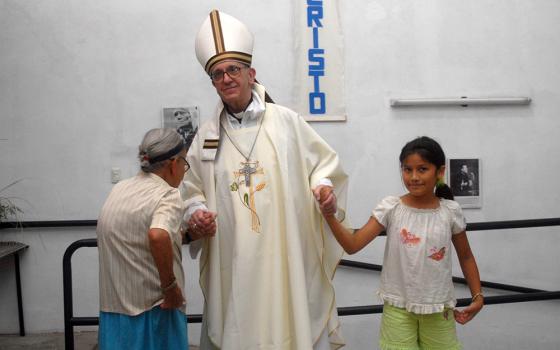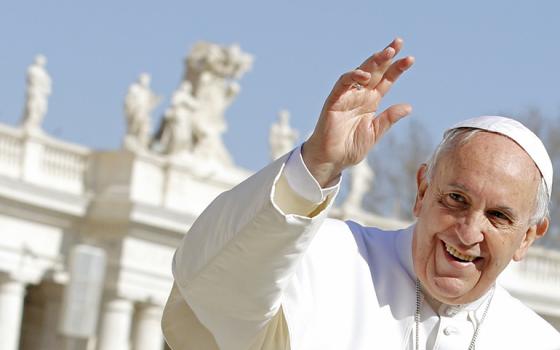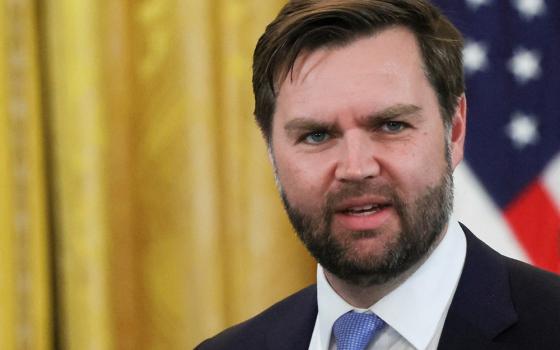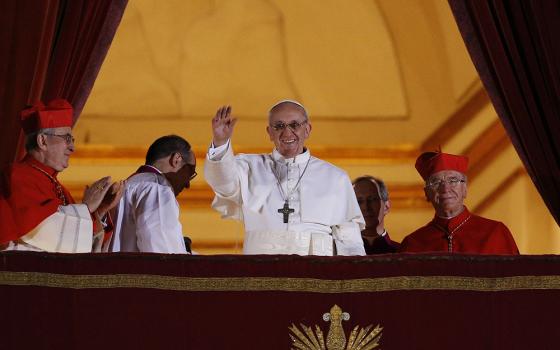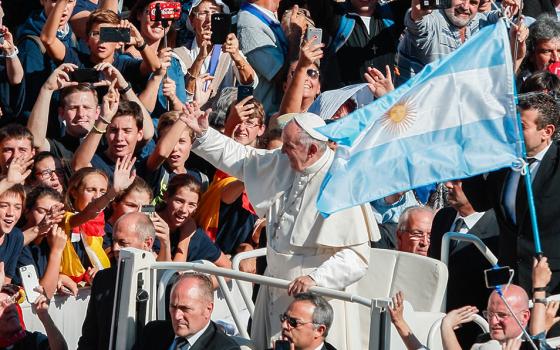Pope Francis arrives for a meeting with women participating in or assisting the Synod of Bishops in the Apostolic Palace at the Vatican Oct. 19, 2024. The synod on synodality, for the first time in history, lay people, including about 50 women, were included as voting members. (CNS/Vatican Media)
Pope Francis appointed about a dozen women to top roles at the Vatican during his 12-year pontificate, and in the last months of his life seemed to step up that commitment, naming the first woman to lead a major Vatican office and choosing a woman as president of the Vatican City State.
He had also previously put a woman in charge of the office overseeing synodality, the process Francis used to increase collaboration in an otherwise top-down institution. During the synod on synodality, for the first time in history, lay people, including about 50 women, were able to vote — and the results of those votes became magisterial teaching. He also changed the Code of Canon Law to explicitly allow women as lectors and altar servers.
Yet Francis, known for his pastoral style and openness to marginalized groups, nonetheless upheld the church's ban on women's ordained ministry to the diaconate and the priesthood. He also frequently railed against "gender ideology" and used outdated language about women.
Francis died April 21 after a stroke, which came after a monthslong respiratory illness.
Although he represented a positive shift from his predecessors on women's issues, Francis' legacy was a mixed bag, according to those advocating for greater leadership roles for women in the church.
Kim Daniels (CNS/Courtesy of Georgetown University/Mark Gregory)
The Vatican appointments of women were "real progress," said Kim Daniels, who was herself tapped to serve on the Vatican Dicastery for Communication and as an expert participant at the synod under Francis. "And at the same time there's no doubt that there's so much more work to be done."
Theologian Sr. Caroline Mbonu said seeing women seated at round tables with bishops, with the ability to vote at the synod, was a powerful example of Francis listening to calls for more leadership opportunities for women. "In my lifetime, I've not heard of anything like this," said Mbonu, a Handmaid of the Holy Child Jesus sister and professor of New Testament at University of Port Harcourt in Nigeria. Women "haven't had it this good until he came on board."
Yet Mbonu, and many other women, were disappointed at Francis' refusal to follow through on restoring the diaconate to include women, after convening two commissions to study the issue.
While acknowledging that Francis "brought a very refreshing and deeply pastoral presence to the papacy," Kate McElwee, executive director of the Women's Ordination Conference, said his opposition to women's ordination felt incongruous.
"When it came to the topic of women in ministry, it seemed like he was stuck in bad theology and misogynistic tropes," she said.
A woman holds a sign in support of women deacons as Pope Francis leads his general audience in St. Peter's Square at the Vatican Nov. 6, 2019. Despite convening two commissions to study the issue, Pope Francis did not approve ordaining women as deacons. (CNS/Paul Haring)
Francis first convened a commission to study women deacons in 2016, after prompting from a group of sisters and nuns. That group members were "unable to come to agreement about the role of women deacons in the early centuries of Christianity," the pope said in 2019. Francis never released the report from that commission, nor from a second group created in 2020.
The issue of women's leadership was raised in every continental report during the three-year synod on synodality and was a topic of conversation at the two synod summits in Rome in 2023 and 2024. The final synod document, however, stopped short of moving on female deacons. In May 2024, the pope told journalist Norah O'Donnell that he opposed ordaining women as deacons. Yet he approved the synodal document, which said "this discernment needs to continue."
Francis also upheld the ban on women's ordination to the priesthood, saying "the last word is clear," referring to Pope John Paul II's 1994 apostolic letter Ordinatio Sacerdotalis, which effectively silenced further discussion on the matter. Francis had said that to ordain women would "clericalize" them. Yet, unlike John Paul II, Francis allowed freedom of discussion — and the Women's Ordination Conference was allowed to participate in the synod, and even had a presence on the synod website.
'He was not perfect, but he modeled a posture of genuine humility and contrition that our church leaders are quick to preach but might be nervous to embrace.'
—Casey Stanton and Ellie Hidalgo
The group Discerning Deacons was founded in 2021 in response to Francis' openness to talking about difficult topics, said co-directors Casey Stanton and Ellie Hidalgo. While they acknowledge that the topic of the diaconate was a point of tension and conflict during the synod meetings in Rome, they believe Francis "modeled an open posture, fostering a space of encounter, dialogue — and encouraged us to continue in our work to be diaconal women, ministering around the world."
"He was not perfect, but he modeled a posture of genuine humility and contrition that our church leaders are quick to preach but might be nervous to embrace," they said in an emailed statement to NCR.
They said Francis' focus on listening and discernment is a healthier way of exercising authority in the church, and that "listening to and believing women's lived experience will be part of Pope Francis' enduring legacy."
Some of Pope Francis' changes were relatively small, but symbolic. Shortly after his March 13, 2013, election, Francis took the Holy Thursday practice of footwashing outside the church walls to a juvenile detention center, where he washed the feet of 10 young men and two women. Three years later, he changed the liturgical rules to make clear that women could be included in the ritual that recreates the Last Supper, where, according to Catholic doctrine, Jesus formally instituted the priesthood. In 2024, he visited a women's prison and washed the feet of only women.
Pope Francis washes the feet of an inmate at the Rebibbia women's prison on the outskirts of Rome as he celebrates the Holy Thursday Mass of the Lord's Supper March 28, 2024. In 2016, he changed the liturgical rules to make clear that women could be included in the ritual that recreates the Last Supper. (CNS/Vatican Media)
Francis' papacy saw a marked increase in the percentage of women working in the Vatican, from 19.3% in 2013 to 23.4% today, according to statistics reported by Vatican News. Just a decade ago, only two women held top positions in the Curia. Today, 1 in 4 employees of the Holy See is a woman. Many of those tapped for top positions are women religious.
Among the high-profile female appointments under Francis were Emilce Cuda, secretary of the Pontifical Commission for Latin America; Salesian Sr. Alessandra Smerilli, secretary of the Dicastery for Promoting Integral Human Development; and Xaviere Sr. Nathalie Becquart, under-secretary of the Vatican's synod office. All these appointments were made in 2021.
In 2022, Francis overhauled the Vatican bureaucracy, with a new apostolic constitution that made it possible for laypeople, including women, to become prefects. In January, just a month before he entered the hospital with double pneumonia, he named the first woman to lead a Vatican department: Consolata Missionary Sr. Simona Brambilla as prefect of the Dicastery for Institutes of Consecrated Life and Societies of Apostolic Life. A few weeks later, another Italian nun, Sr. Raffaella Petrini, moved from the No. 2 position at the Vatican City State into the top position.
In Brambilla's case, Francis named a cardinal as "pro-prefect" or co-leader of the office, leading some to criticize the arrangement as possibly diluting her authority.
Pope Francis greets Consolata Missionary Sr. Simona Brambilla, prefect of the Dicastery for Institutes of Consecrated Life and Societies of Apostolic Life after an evening prayer service in St. Peter's Basilica at the Vatican Feb. 1, 2025, the eve of the feast of the Presentation of the Lord and the World Day for Consecrated Life. (CNS/Vatican Media)
Francis also occasionally took heat for his comments about women, as he sometimes used language that emphasized motherhood and family over roles outside the home.
For example, during a visit to the University of Louvain in September, Francis said: "The woman is more important than the man, but it's bad when the woman wants to be a man," adding that "a woman within the People of God is a daughter, a sister, a mother." The comments prompted the Catholic university in Belgium to issue a statement saying they disagreed with the pope's comments about women.
Aboard the papal plane after the trip, Francis doubled down on his comments, using gendered imagery of Jesus and the church, as he frequently did, to explain women's roles. "I always talk about the dignity of women," he said. "I said something that I cannot say about men: The Church is woman, she is the bride of Jesus. To masculinize women is not human. Women, I always say, are more important than men, because the Church is the bride of Jesus."
Francis also sometimes echoed Pope John Paul II in referring to women’s special "feminine genius," and once called female theologians "strawberries on the cake." In 2014, less than a year into his papacy, a columnist compiled seven examples of dated, sexist language the pope had used.
Theologian Cecilia González-Andrieu of Loyola Marymount University in Los Angeles, who met with Francis last fall as part of a delegation of women's ministry advocates — and served as the pope's translator for the meeting — believes some of Francis' comments about women merely reflect that he is "a man of his period."
Francis reminds González-Andrieu of her own father, another Latin American man of the same generation. "They value and revere and are very appreciative of women, which for them is already kind of radical," she said.
"I don't think Pope Francis has ever meant anything to demean women," she said.
As a Latin American theologian, she also appreciates how Francis worked to change underlying structures to facilitate change. "During our conversation, he talked about how putting women in positions where they had never been before is changing the way things operate, and that it would lead to things flourishing, to things blooming that were stagnant," she said.
Xavière Missionary Sr. Nathalie Becquart, undersecretary of the Synod of Bishops, speaks at a press briefing about the Synod of Bishops at the Vatican Oct. 21, 2024. (CNS/Lola Gomez)
The synod's final document, which Francis approved as part of the papal magisterium rather than issue his own post-synodal apostolic exhortation, recognizes that "women continue to encounter obstacles in obtaining a fuller recognition of their charisms, vocation and place in all the various areas of the Church's life." It also notes that this harms the church's mission, and that there is nothing preventing women from carrying out leadership roles in the church.
Advertisement
Daniels, who is director of the Initiative on Catholic Social Thought and Public Life at Georgetown University, hopes the precedent of increasing women's leadership in the church continues after Francis.
"Moving to a much more robust presence of women in leadership roles at the Vatican would strengthen decision-making, help change the culture of clericalism and demonstrate the effective follow-up to the synod that Pope Francis has called for," she said.
McElwee also is grateful for how much the church changed under Francis.
"Even though Pope Francis himself seemed personally closed off to women in ministry, he opened a lot of dialogues and allowed those dialogues to happen at high levels in the church," she said. "I hope and pray that his successor will build on that spirit of courageous dialogue."

